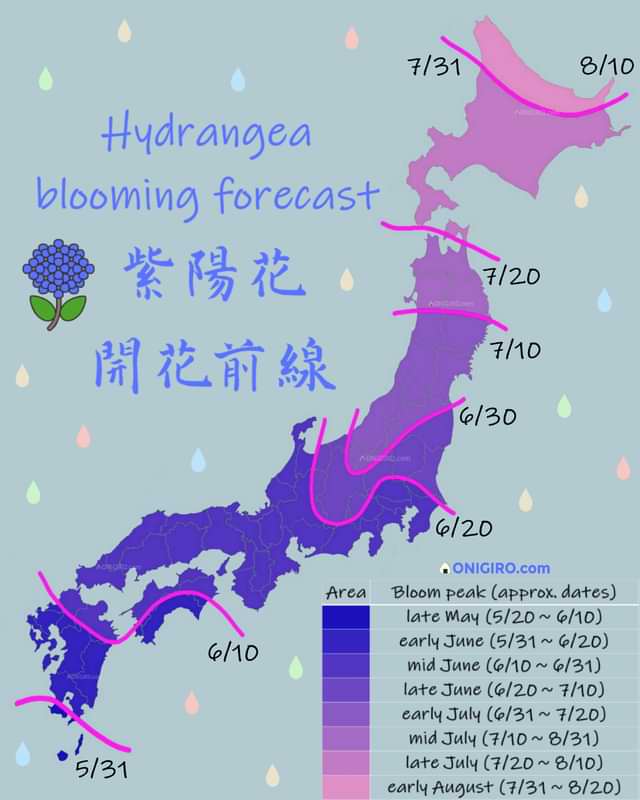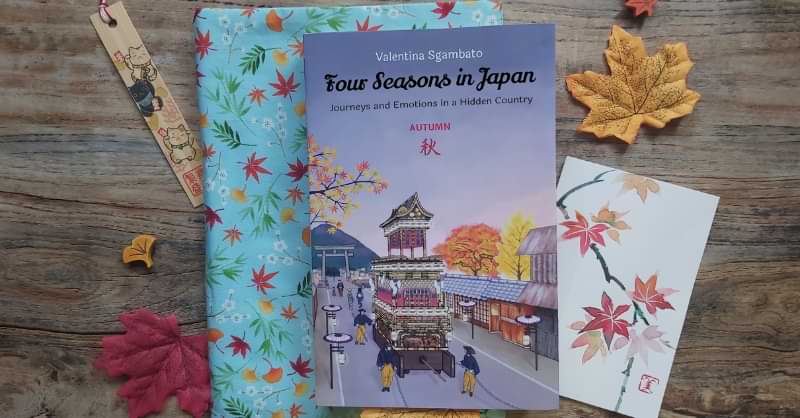Ajisai, the Japanese Hydrangea
Find out more about ajisai, the Japanese hydrangea, one of the most beautiful flowers native to the east asia!
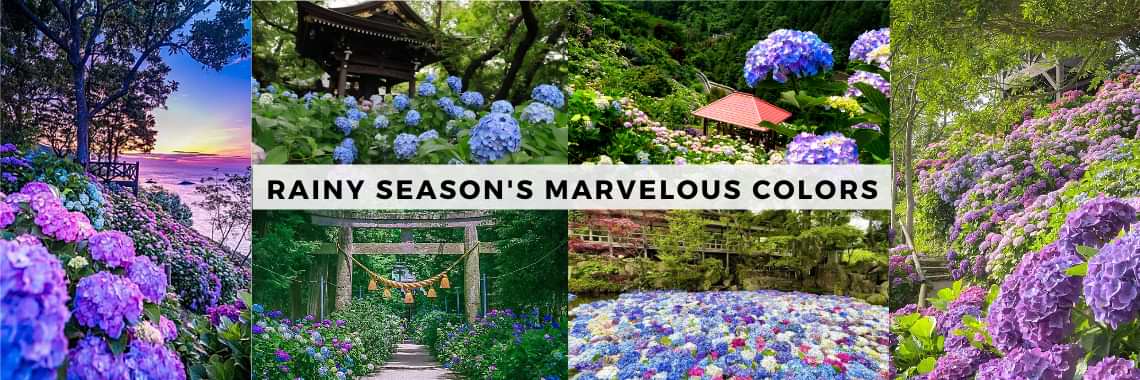
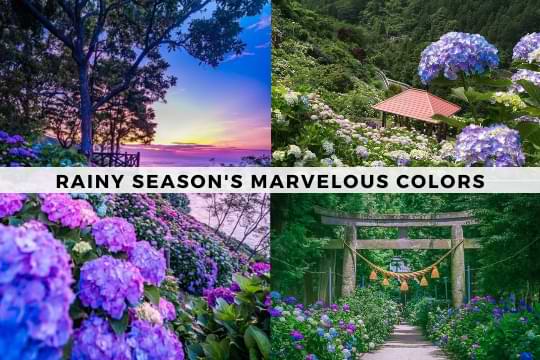
June, in Japan, is the month of ajisai, the flowering of which heralds the arrival of rainy season. If you think that this month is not ideal to visit Japan due to the frequent rains, short but cool, you will soon change your mind: at the beginning of summer the scenarios are tinged with the vivid colors of Japanese hydrangeas, such as blue, white, purple and lavender, sculpting memories that are hard to forget in a land where nature reigns supreme.
Below you can consult the Japanese hydrangea blooming forecast map in the various regions, useful for planning your trip in search of the best places to admire them:
Characteristics of hydrangea
Belonging to the Hydrangeaceae family, hydrangea is a plant native to Japan and China and its origins are very ancient, as evidenced by the fossil traces dating back to 40-65 million years ago. The kanji that make up the word ajisai are 紫陽 花, where 紫 stands for “purple, violet”, 陽 for “sunset, positivity” and 花 for “flower”.
To date, there are more than 30 different species of hydrangeas and hundreds of subspecies including cultivars and spontaneous varieties. Some species are woody climbers, while others are shrubby plants, but all Japanese hydrangeas share a sturdy stem and lobed or toothed leaves. The flowers are gathered in more or less spherical inflorescences called corymbs, or panicles. Depending on the type of plant, the shrub can reach up to 6 meters in height.
Furthermore, hydrangea is slightly poisonous for both humans and animals: their leaves contain cyanogenic glycosides which, if absorbed by the body, about half an hour after ingestion cause various unpleasant symptoms, such as nausea, vomiting and dizziness.
Despite this, the roots of this plant are instead used for medicinal purposes as they are antioxidants capable of relieving kidney pain.
Color and meaning of Japanese hydrangea
The color of the corymbs depends on the acidity of the soil in which the plants are grown: the pigment of hydrangeas is in fact closely linked to the presence of aluminum ions in the soil. Furthermore, in soils characterized by different levels of acidity, the flowers will have different shades even if they are part of the same plant.
To obtain flowers with a blue color it is necessary to plant hydrangeas in acid soils with a pH lower than 5.5, while for a purple color the ideal pH is between 5.5 and 6.5. Finally, if the soil is basic with a pH above 7, the corymbs will have pink or red shades.
Hydrangeas take on a different meaning based on the color of the corymbs:
- white – righteousness, purity, goodness, thoughtfulness and innocence;
- pink – happiness, cheerfulness, warmth, love, affection and sincere feelings;
- purple – calm, calm, long-lasting, understanding and creativity;
- blue – love, adoration, fidelity, sincerity, forgiveness, remorse and spirituality.
Thanks to its countless meanings, hydrangea is suitable for many occasions and can be a beautiful gift for joyful moments, thanking a loved one or expressing one’s affection.
Hydrangea in Japan
In Japan, ajisai is a plant linked to the breathtaking landscapes of the rainy season: after losing all its leaves in the colder season, the Japanese hydrangea regains its natural splendor in late spring and early summer.
Also called “Rose of Japan”, hydrangea is one of the most revered flowers by the Japanese people. Just think of the various seasonal objects on which it is represented, such as the fabrics of the yukata, the ceramics or the typical sweets of the tea ceremony, the wagashi.
As with many other natural elements, Japanese myths and legends are also hidden behind the ajisai. One of these tells that, to remedy the fact of having neglected it due to work emergencies, a Japanese emperor gave beautiful blue hydrangeas to the family of the girl he loved. With this gift he wanted to show all the love and sorrow for the conduct he maintained and even today, in fact, hydrangea is associated with a feeling of sincere emotion, apologies and gratitude for the understanding received.
History of Japanese hydrangea
The ajisai have a long history within Japanese culture as, already during the Nara period (710-794), they were frequently the subject of haiku and present in the literature of the time.
Furthermore, due to its mutability, hydrangea was honored by the samurai of the Edo period (1603-1868): according to these fighters, the ability of hydrangea flowers to change color depending on the environment was an incredible quality that made every unique flower and symbol of immortality.
Unfortunately, during the closure of the borders of Japan wanted by Tokugawa Iemitsu between 1639 and 1856, known as sakoku, the access and distribution of the many varieties of Japanese hydrangeas around the world was drastically slowed down.
Amacha 甘茶, hydrangea's sweet tea
Although, as mentioned above, hydrangeas are slightly poisonous plants, there are some varieties from which it is possible to obtain a particular infusion known as “sweet hydrangea tea”. We are talking about hydrangeas such as Amacha, native to central Honshū, and Amagi Amacha, from the Izu peninsula, both belonging to the species of Hydrangea macrophylla serrata (or yamaajisai).
The infusion made from these hydrangeas does not contain caffeine and has a marked sweet taste, thanks to a natural sweetener present in the leaves, phyllodulcin, a sweetener up to 200 times sweeter than sucrose. This sweetener has always been used as a sweetener and ingredient in drugs for all people suffering from diabetes.
To produce this infusion, the leaves are harvested just before flowering, at which time they are extremely bitter. Then follows a drying phase, rolling by hand and then a fermentation before proceeding with the drying necessary for maintenance. The fermentation phase is essential to transform the chemicals, source of the bitter taste of the leaves, into the sweet phyllodulcin.
However, drinking too strong Amacha can lead to food poisoning so much so that the Japanese Ministry of Health recommends not exceeding 3 grams of Amacha leaves per liter of water.
Kambutsue 灌仏会, Buddha's birthday
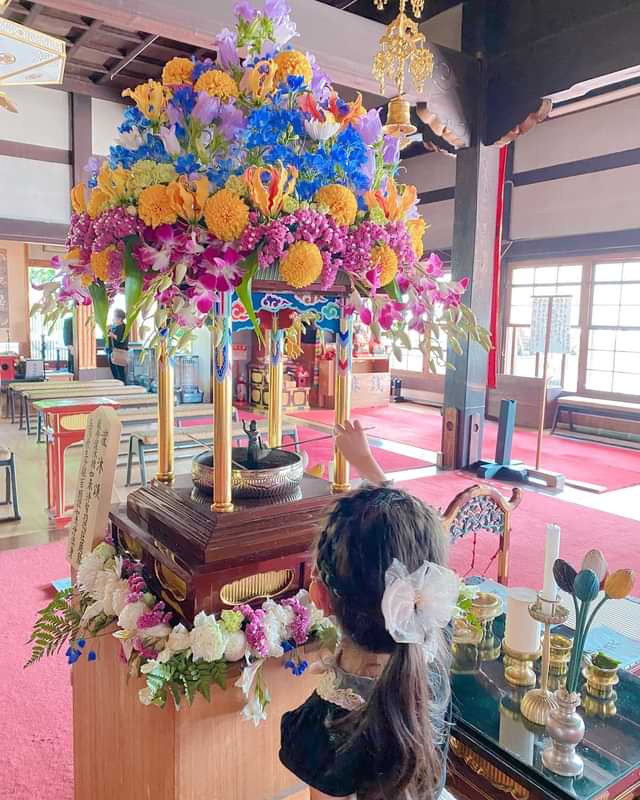
Amacha is used during the Kambutsue (commonly called Hana Masturi 花祭, the flower festival), one of the most famous festivals in Japan that takes place every year on April 8 to celebrate the birth of Buddha.
The ceremony consists of setting up the “flower room”, the Hanamidō, in which numerous types of flowers of the most disparate colors are arranged. A small statue of Buddha is placed in the center of a lotus flower and washed with sweet hydrangea tea, poured three times by visitors with a bamboo spoon. The employees of the temples have the task of preparing large quantities of this infusion in advance to be able to distribute it to all the participants.
During Kambutsue, tea made from hydrangeas acquires a profound meaning as, according to legend, it represents the pure water poured by dragons on the Buddha’s head to wash it on the occasion of his birth.
Finally, recurring with this holiday, in ancient times people wrote spells with the ink obtained from the Amacha and hung them upside down outside the gate of their home, convinced that the magical powers of this ink would keep snakes and other unwanted animals away.
Best places to see hydrangea in Japan
Japanese hydrangeas can be admired in city parks and along the banks of rivers, but also in the gardens of temples and shrines. In the latter, the flowers of the ajisai are also used for the hanachōzu 花手水 at the purification fountains at the entrance of the same, covering the surfaces with color.
Furthermore, in the parks of some smaller towns, the quantity of ajisai is so high that it is one of the main attractions of the locality, earning the name of ajisai matsuri (or hydrangea festival) attracting photographers and tourists from the neighboring regions.
Following, an interactive map showing all the places where you can see Japanese hydrangeas and a selection of the best places not to be missed if you travel to Japan between June and July!
Tōgenkyō misaki 桃源郷岬
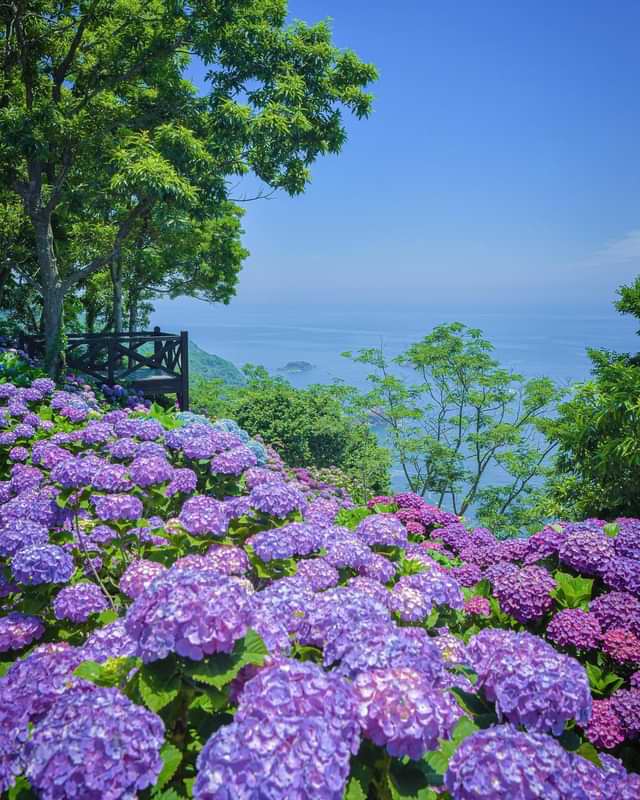
This headland in the remote Miyazaki Prefecture on the east coast of Kyūshū aspires to be Japan’s most beautiful hydrangea garden. In the park there are an estimated two million hydrangeas and from the balcony surrounded by flowers you have an excellent view of the sea and the islands inside.
Nearby there is the observation point of Mount Tomi, a 360 ° view of the entire surrounding area. Unfortunately, the location can only be reached by car, with the nearest train station approximately 8km away. The entrance fee to the park is around ¥ 1000 during the beginning of June, when the hydrangeas are in full bloom.
Shimoda-kōen 下田公園
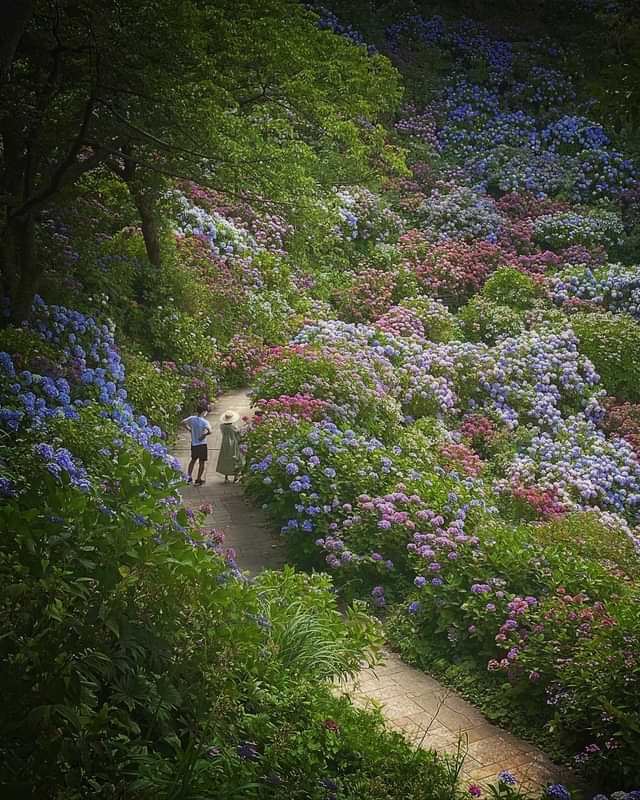
Shimoda-kōen is located in the coastal city of the same name, in the southern part of the Izu peninsula, famous for onsen, beaches and marine sports. This park stands on an elevated position, a hill near the city center where Shimoda Castle once stood, whose ruins can be admired today.
Shimoda-kōen is home to more than a thousand ajisai, which reach maximum bloom in June, and is also the site of the Monument to the opening of diplomatic relations between Japan and the United States, built in 1957.
Amabiki Kannon 雨引観音
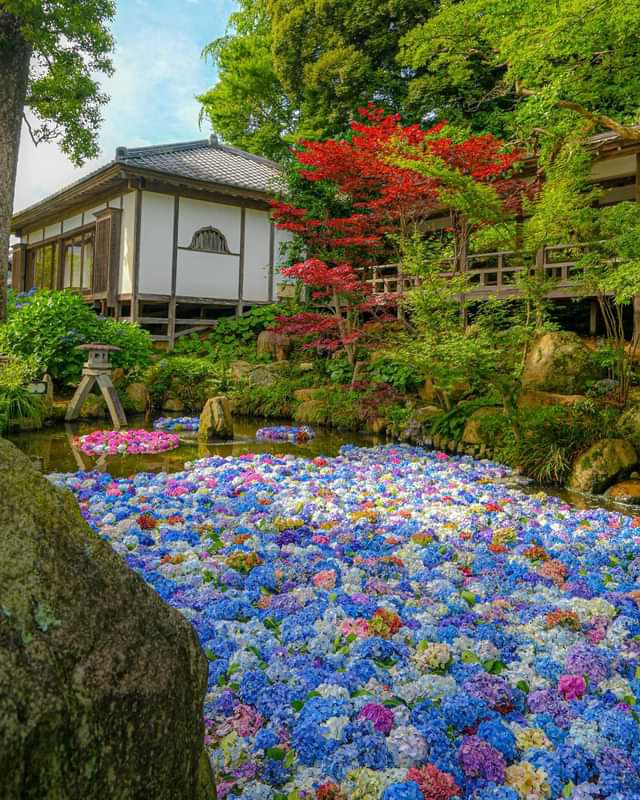
The Amabikisan Rakuhō-ji temple (commonly called Amabiki Kannon), in Ibaraki prefecture, is estimated to date back to 587 and is a destination for many visitors seeking blessings regarding safe delivery or proper childbirth.
The temple houses an over 1500-year-old statue of Bodhisattva Kannon, the deity of mercy for Buddhism. The statue is visible only on the first Sunday of April.
Reachable with a 7km drive from the nearest train station, during the rainy season the temple receives many visits from nature lovers due to the wonderful pond in which hundreds of hydrangea flowers are floated.
Kaisei ajisai-no-sato 開成あじさいの里

In early June, the small town of Kaisei, in Kanagawa prefecture, hosts a hydrangea festival with over 10,000 plants in bloom along the streets, among irrigated rice fields reflecting the setting sun.
To reach the area, the nearest train station is Matsuda station. Once off the train, proceed by crossing the river and continuing west for 2km.
Ōhirasan ajisai-zaka 太平山あじさい坂
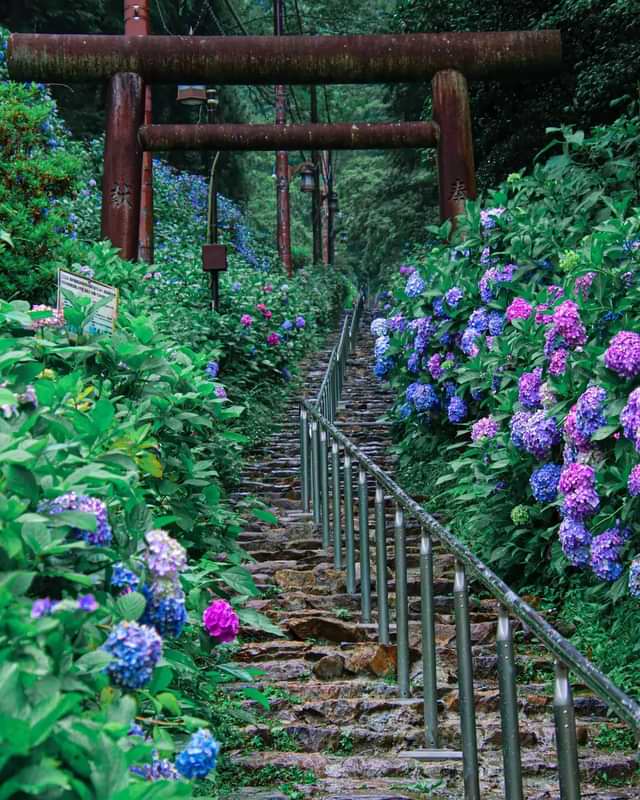
Mount Ōhira, in Tochigi prefecture, is one of the most popular destinations during the rainy season due to its proximity to Tōkyō. During the second half of June, on the sides of the 1000 steps to reach the top of the hill, over 2500 hydrangea plants will make the climb more pleasant.
The scenario is truly unique, also due to the various giant torii under which you pass along the way. To reach the beginning of the climb, the nearest train station is Tochigi station, from which you can take a bus for about 4km.
Maizuru shizen-bunka-kōen 舞鶴自然文化公園
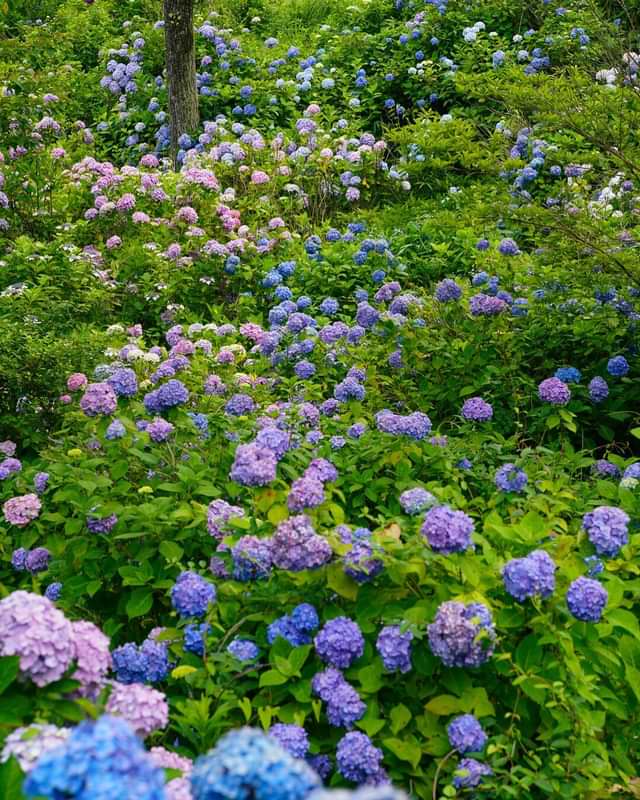
The nature and culture park of Maizuru, a small town north of Kyōto, is famous both for the camellia flowers, in bloom at the end of March, and for the many hydrangeas inside. The only way to reach it is by car, as the nearest train station is 12km away.
The wooden palisades along the path offer panoramic views of the surrounding hydrangea sea. The hydrangea park is only open for a couple of weeks in mid-June, from 9:00 to 17:00, and the cost of admission is around ¥ 500.
Yasunami suisha-no-sato 安並水車の里
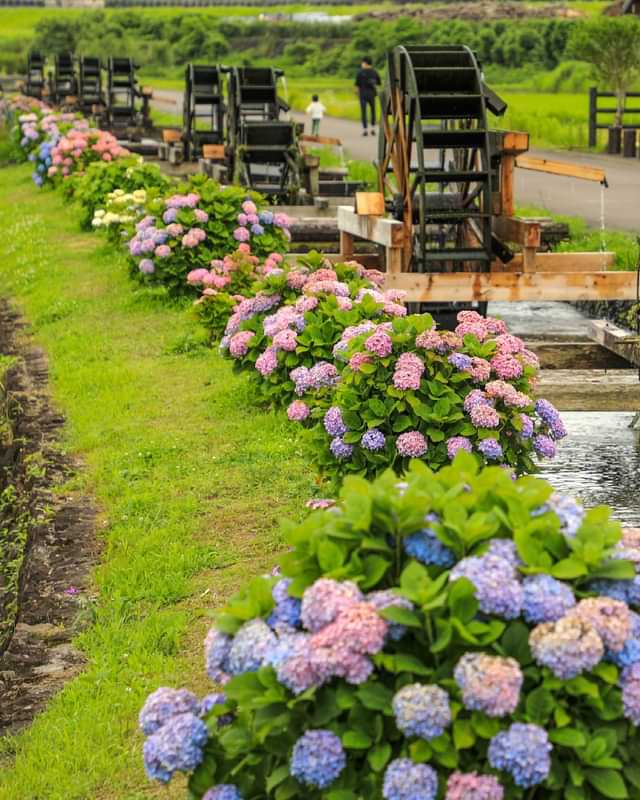
In the remote prefecture of Kōchi, south of Shikoku, flows one of the clearest rivers in Japan, the Shimanto River. Near the mouth of the latter, several streams of water join before throwing themselves into the ocean, and one of these streams is bordered by many beautiful hydrangea bushes.
This small river of clear water is one of a kind as it features several water wheels that were formerly used to irrigate the surrounding rice fields. To date, however, there are few left and only for tourism, as the fields are irrigated in other ways.
Seki-shi Itadori Ajisai Matsuri 関市板取あじさいまつり
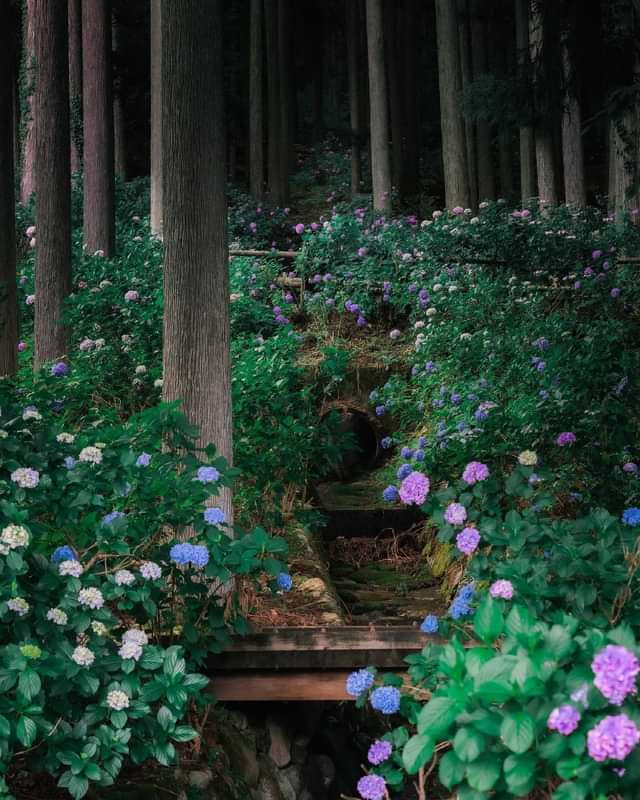
The village of Itadori, in the small town of Seki, is famous throughout Japan for the Seki-shi Itadori Ajisai Matsuri, the hydrangea festival that attracts photographers from all neighboring regions between mid-June and early July, with various events to entertain. the many visitors.
In this period it is possible to enjoy the magnificent multicolored view of “Hydrangea’s road”: on the banks of the Itadori river, a 24 km long path is animated by about 7,000 Japanese hydrangea plants of various colors positioned on the sides of the road. If we add the approximately 3,000 other hydrangeas located in the 21st Century Forest Park, Itadori boasts a unique landscape with a total of approximately 10,000 ajisai.
Takahata-Fudōson Kongō-ji 高幡不動尊金剛寺
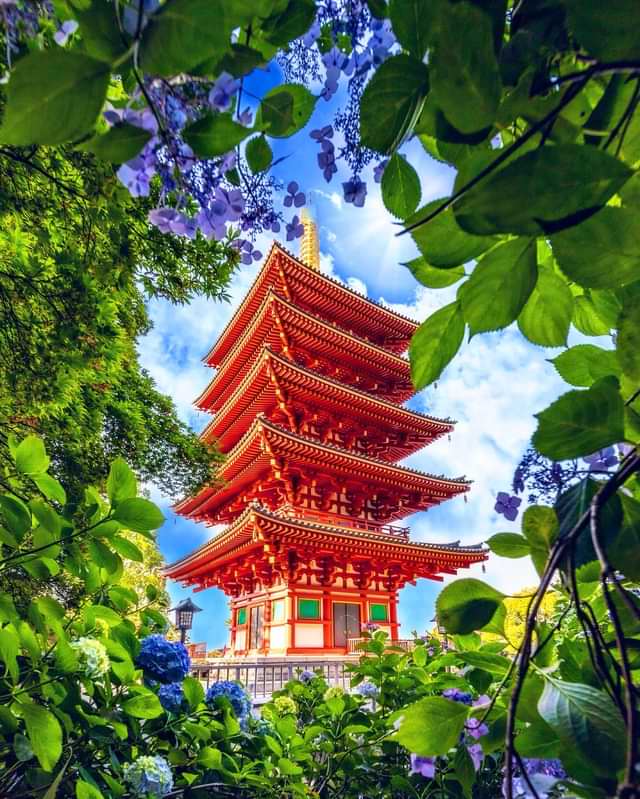
Takahata-Fudōson Kongō-ji is a temple that dates back to the 8th century and is located in Hino, Tōkyō prefecture. It is dedicated to Fudō Myō-ō, the furious protector of Buddhist teachings, and his largest wooden representation of the whole Kantō region is kept inside the temple.
From mid-June to mid-July the temple pagoda, 45 meters high and with 5 floors, is surrounded by 7,500 hydrangea flowers of 200 different varieties. On the hill behind the temple you can also see a truly suggestive atmosphere, where 88 Jizō statues are surrounded by these centenary flowers.
Hydrangea macrophylla
Hydrangea macrophylla is the most widespread species of hydrangea native to Japan in the world, whose flowering lasts from 6 to 8 weeks and in some cases lasts until the beginning of autumn. Admiring the ajisai in this period is certainly a unique experience: the blue flowers take on burgundy tones, while the red ones become pale green or even intense red.
This Japanese hydrangea species falls into three varieties (or subspecies): mophead, lacecap, and serrata.
Hydrangea macrophylla mophead (honajisai)
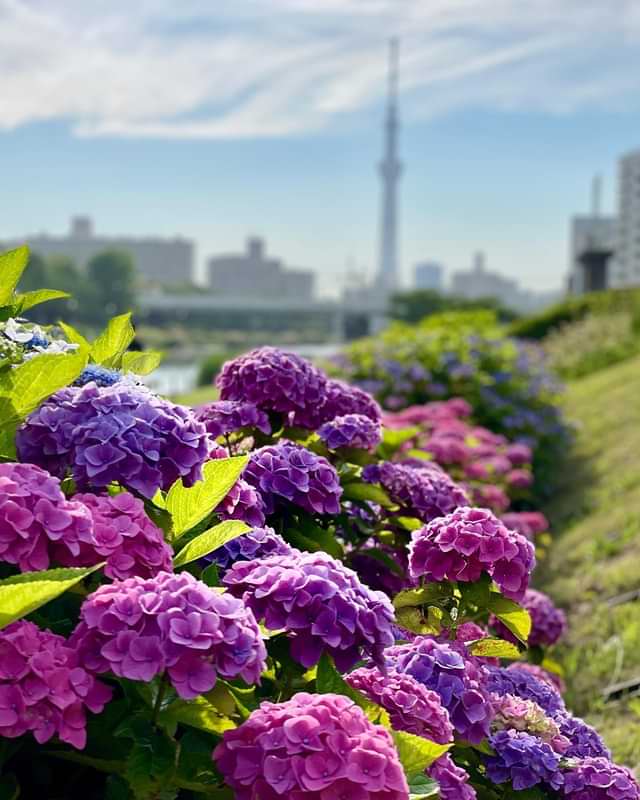
The Hydrangea macrophylla mophead, called in Japanese honajisai (本 紫陽 花 or ホ ン ア ジ サ イ), is the most common due to the unique shape of its flowers. This hydrangea has oval inflorescences up to 30 cm large, composed of sterile flosculi (they cannot be pollinated) and large decorative petaloid sepals.
The sterile flowers are formed by four sepals, which are serrated or smooth, rounded and superimposed on each other. The leaves have an elliptical and pointed shape, with toothed margins. They are bright green in color and, unlike other types of hydrangeas, are larger in size so as to obtain the nickname “bigleaf hydrangeas”.
These honajisai reach a height of between 1.5 and 2 meters. Fortunately for gardeners, these shrubs are simple to care for and don’t require a lot of work.
Hydrangea macrophylla lacecap (gakuajisai)
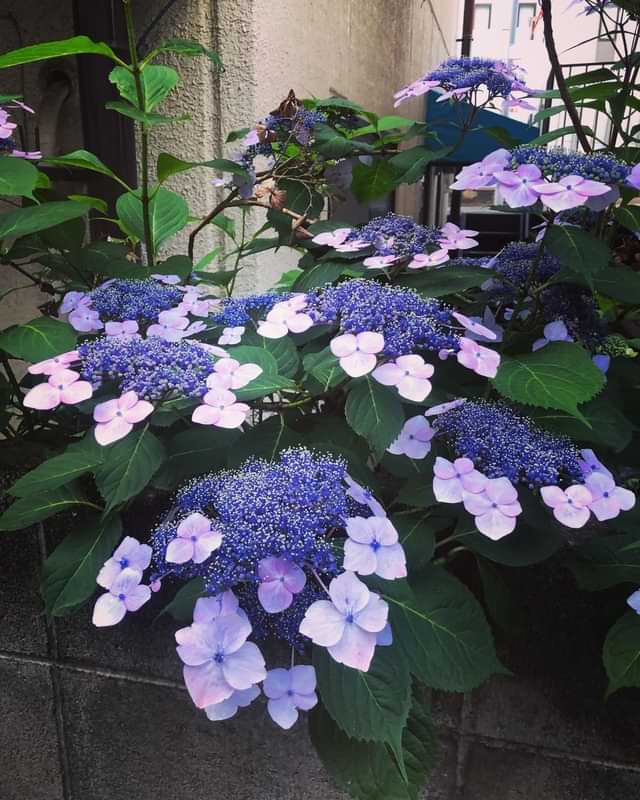
The Japanese name for the Hydrangea macrophylla lacecap is gakuajisai (額 紫陽 花 or ガ ク ア ジ サ イ): it is a plant characterized by early flowering of the outer petals, which frame the later central petals.
Even the gakuajisai does not need a lot of attention, as long as the choice of the soil in which it will be planted is made following the right criterion. Lacecaps, in fact, grow better if planted in places that provide both sunny hours and periods of shade: the ideal would be, for example, a ground beaten by the morning sun and placed in a cool place during the afternoon.
Hydrangea macrophylla serrata (yamaajisai)
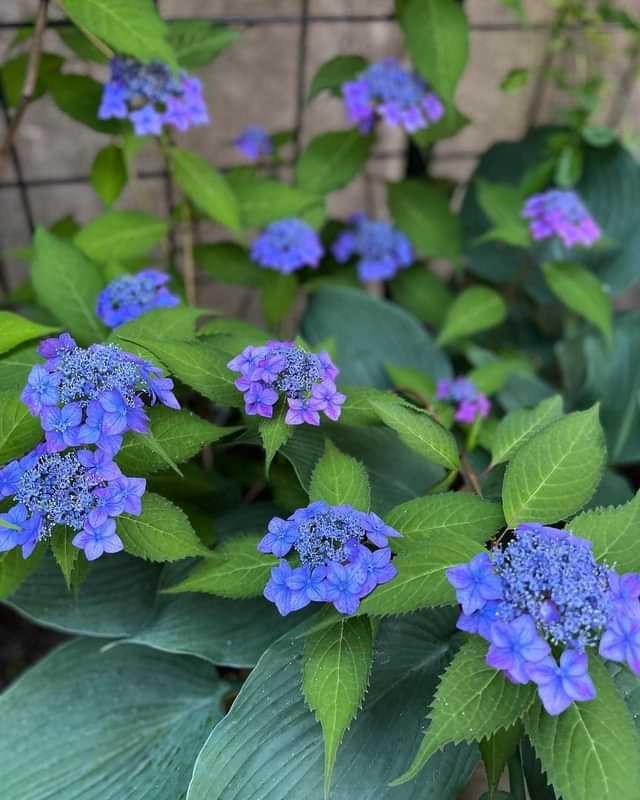
Hydrangea macrophylla serrata is native to the mountainous areas of Japan and Korea, hence the Japanese name yamaajisai (山 紫陽 花 or ヤ マ ア ジ サ イ), or “mountain hydrangea”.
Like the other species, it prefers medium humidity soils located partially in the shade and is able to withstand the hot rays of the sun only if cultivated in constantly humid soils, but it can withstand temperatures that drop down to -25 ° C, although late frosts can compromise its flowering.
This hydrangea reaches about one meter in height, the flowers bloom like the gakuajisai and the leaves are dark green about 15 cm long, with an oval shape and a toothed edge. A peculiarity that unites the hydrangeas of this species is that, compared to other species, the color of the petals is little (or sometimes not at all) influenced by the acidity of the soil.
There are many different varieties of these mountain hydrangeas, all originating from various regions of Japan and whose petals change in shape, size and color. The most famous are detailed in the next section.
Japanese varieties of yamaajisai
Numerous varieties originating from specific areas of Japan refer to the category of yamaajisai, of which we report the best known. For an exhaustive list of all the varieties of Japanese hydrangeas, refer to the dictionary of the Kōbe Park website.
Amacha
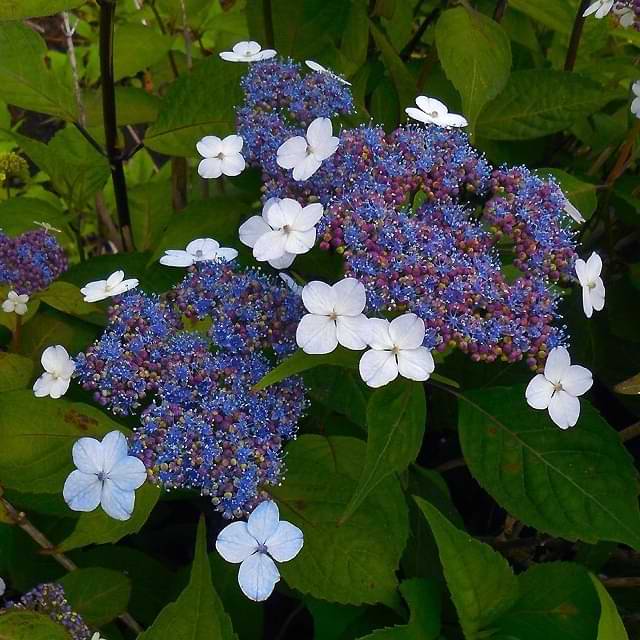
The Amacha variety (甘茶 o アマチャ) is famous for the sweet hydrangea tea that is made from its leaves, and is native to the Chūbu region. The color of the corymbs is blue while the petals, albeit slightly influenced by the acidity of the soil, are a very light blue tending to white.
Amagi Amacha
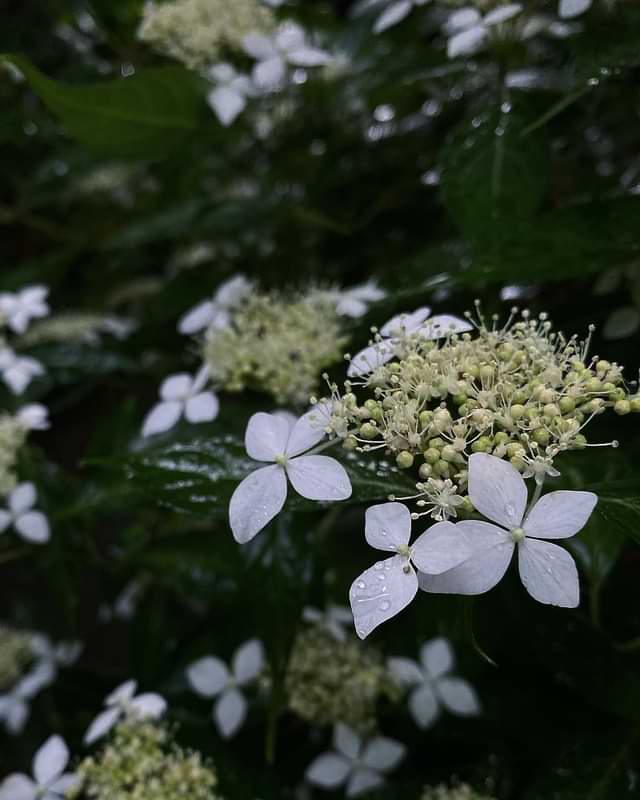
The Amagi Amacha variety (天城甘茶 o アマギアマチャ) is native to Mount Amagi, in the Izu Peninsula of Shizuoka Prefecture. Both the corymbs and the petals are white in color and are not affected by the acidity of the soil. Sweet hydrangea tea is also obtained from this variety.
Benigaku
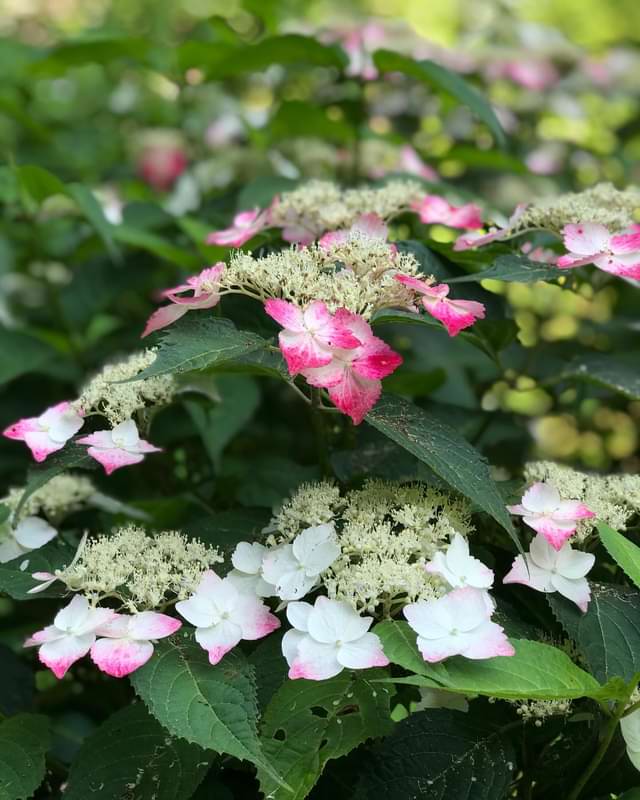
Of the Benigaku variety (紅額 or ベニガク), although it has been cultivated since the Edo period, the place of origin is unknown. The corymbs are green tending to yellow and the petals, slightly overlapping each other, are completely white when they blossom and then slowly turn a crimson hue starting from the edges almost to the central part.
Ezo
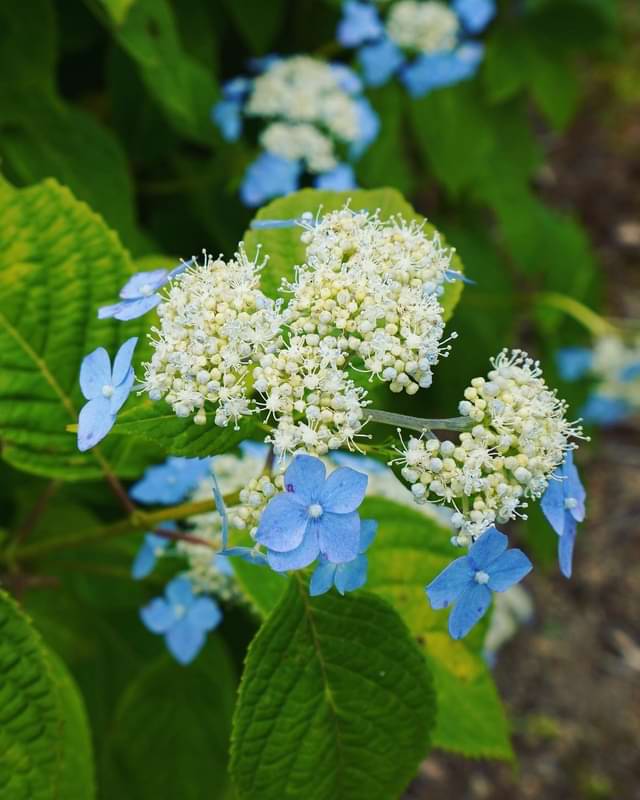
The Ezo variety (蝦夷 or エゾ) is native to the Tōhoku, in particular from the side of the Sea of Japan, plagued by abundant snowfalls. Its branches are very flexible to withstand the weight of the snow and its size can reach double that of other yamaajisai.
The color of the flowers is influenced by the acidity of the soil, but generally the corymbs are white while the petals are light blue not overlapping.
Hakuchō
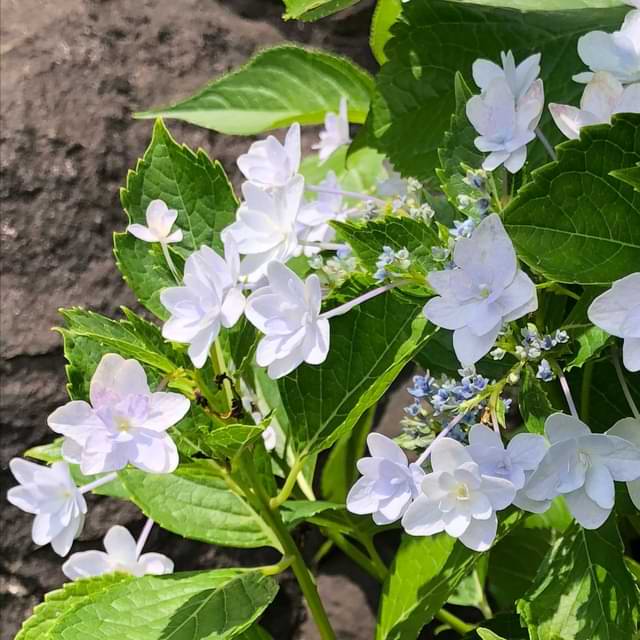
The Hakuchō variety (白鳥 or ハクチョウ) is native to the slopes of Mount Fuji, in Shizuoka prefecture. The petals are Yae-shaped (double star) and completely white, hence the name Hakuchō, “swan” in Japanese.
Kaikyō

The Kaikyō variety (海峡 or カイキョウ) is native to the Korean island of Jeju, west of the island of Kyūshū, and is characterized by dark indigo corymbs and petals.
Kiyosumisawa
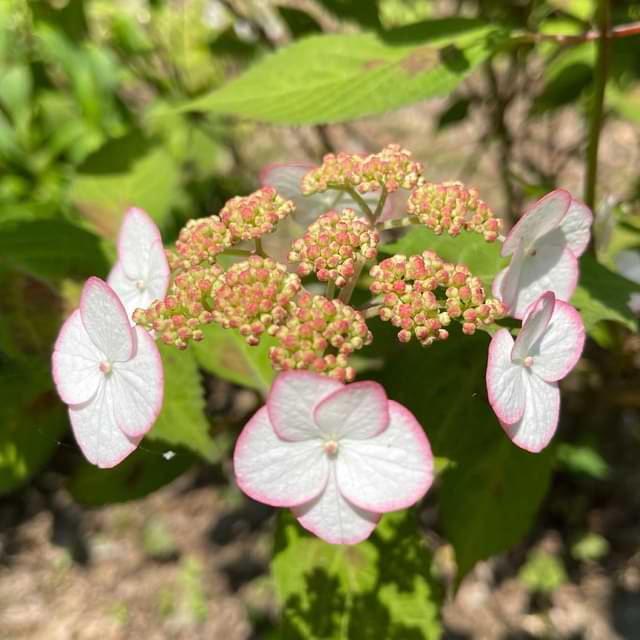
The Kiyosumisawa variety (清澄 沢 or キヨスミサワ) is native to Mount Kiyosumi, Chiba prefecture.
The petals are white with the edge tending to pink and the leaves change their color over time: initially, in spring, the leaves are of an intense purple color; then, approaching the summer and the flowering period, the red is replaced with the classic green of the other hydrangeas.
Kurenai
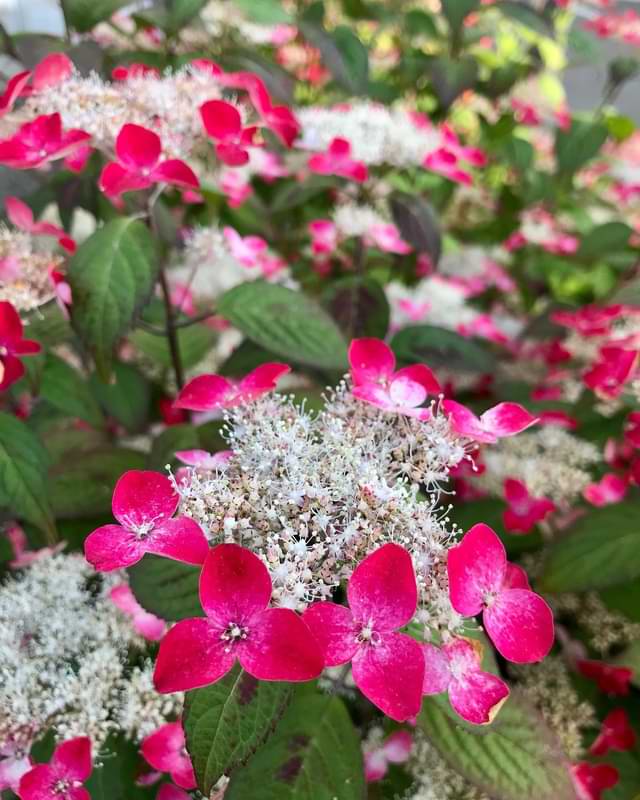
The Kurenai variety (紅 or クレナイ) originates from the city of Iida, in the Nagano prefecture. The corymbs are white, the same color as the petals at the time of flowering. Then, gradually, each petal changes its color until it reaches crimson.
Kurohime
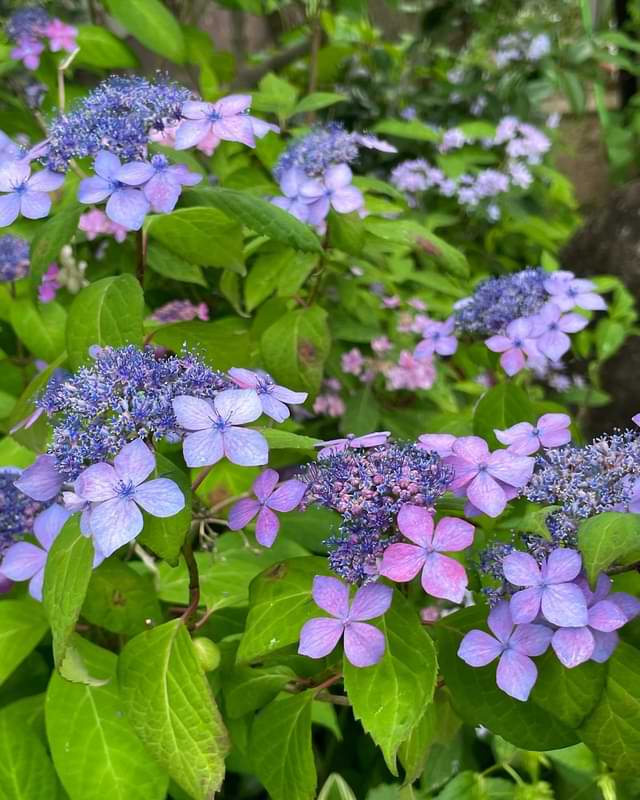
The Kurohime variety (黒姫 or クロヒメ) presents inflorescences of magnificent beauty thanks to their intense purple and blue tones, depending on the acidity of the soil. Furthermore, as also indicated by the name, the branches are particularly dark and tending to black, “kuro” in Japanese.
Maiko
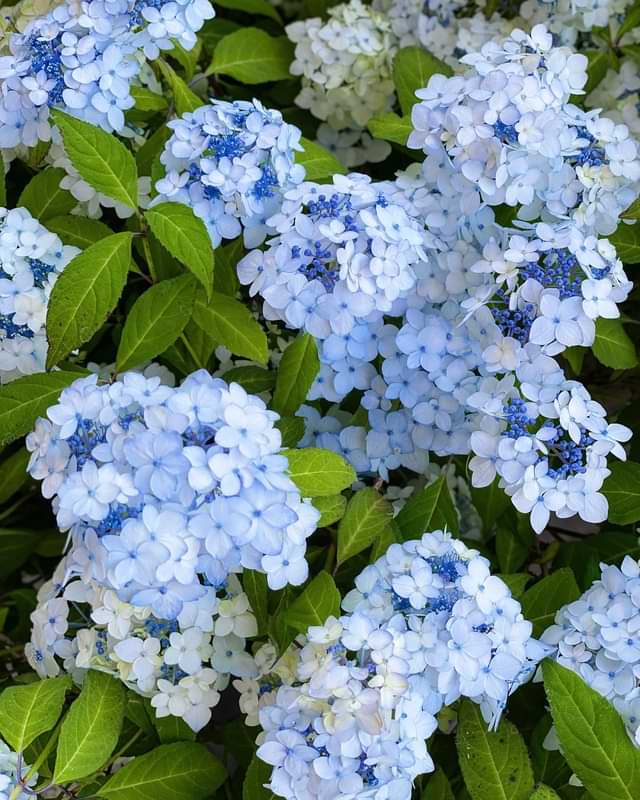
The Maiko variety (舞妓 or マイコ) is native to the Misugi village, in Mie prefecture. This mountain hydrangea tends to bloom again in late summer, with blue corymbs and white petals with a light blue edge.
It differs from most mountain hydrangeas in that it has a spherical bloom referred to as “Temari” rather than the outer ring bloom like gakuajisai.
Mikata Yae
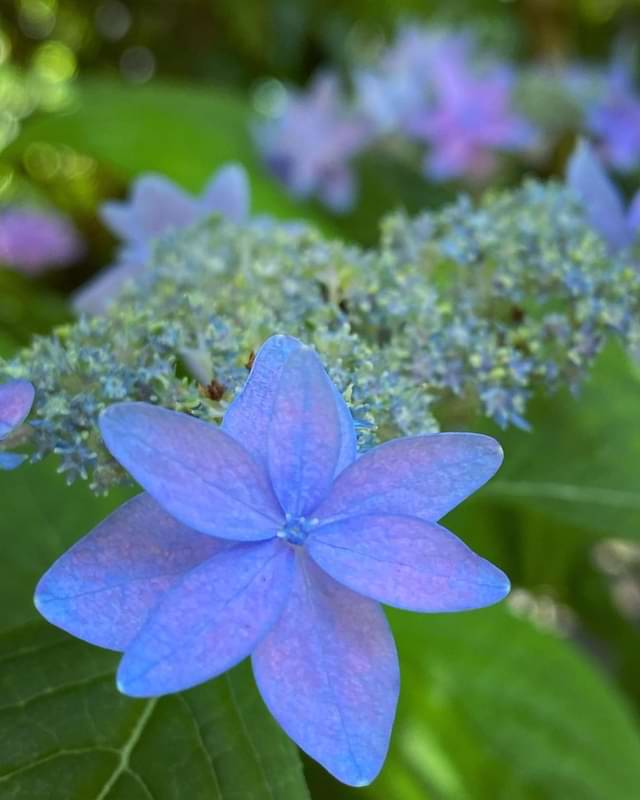
The Mikata Yae variety (美方八重 or ミカタヤエ) is native to Mount Hachibushi, in Hyōgo prefecture. The inflorescences are of the double star Yae type, with colors ranging from light blue to light purple depending on the acidity of the soil.
Miyama Yae Murasaki
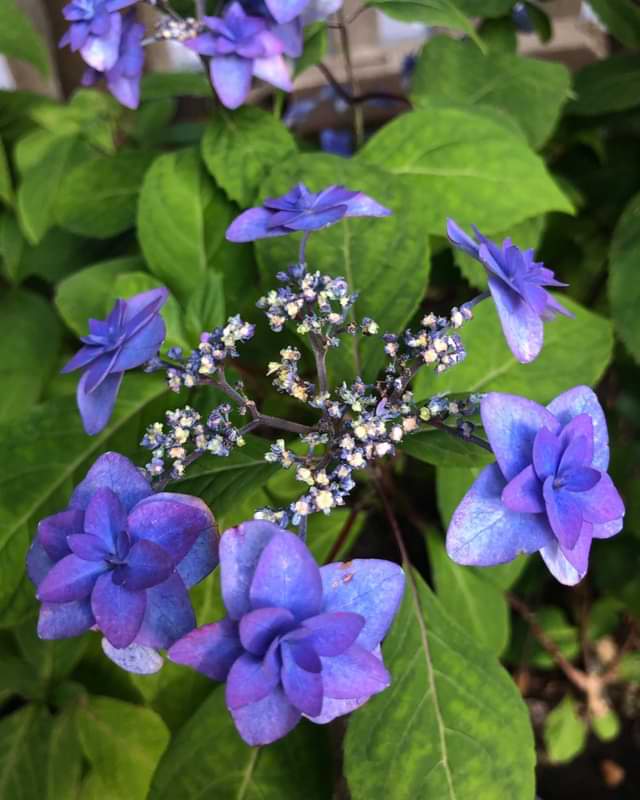
The Miyama Yae Murasaki variety (深山 八 重 紫 or ミヤマヤエムラサキ) is native to the city of Miyama, Kyōto prefecture. “Murasaki” means “purple” in Japanese, and is the color of the corymbs and petals if the plant is planted in fairly acidic soil.
Ōniji
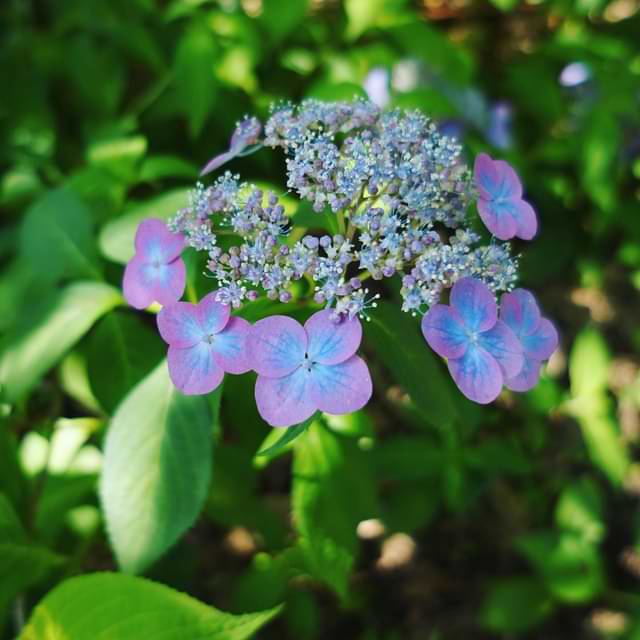
The Ōniji variety (大 虹 or オ オ ニ ジ) originates from the Ehime prefecture, on the island of Shikoku. The colors of its petals have many shades: blue inside and then move on to dark blue, purple and finally lilac, like a rainbow above the rainy sky (大虹 means great rainbow).
Senhime
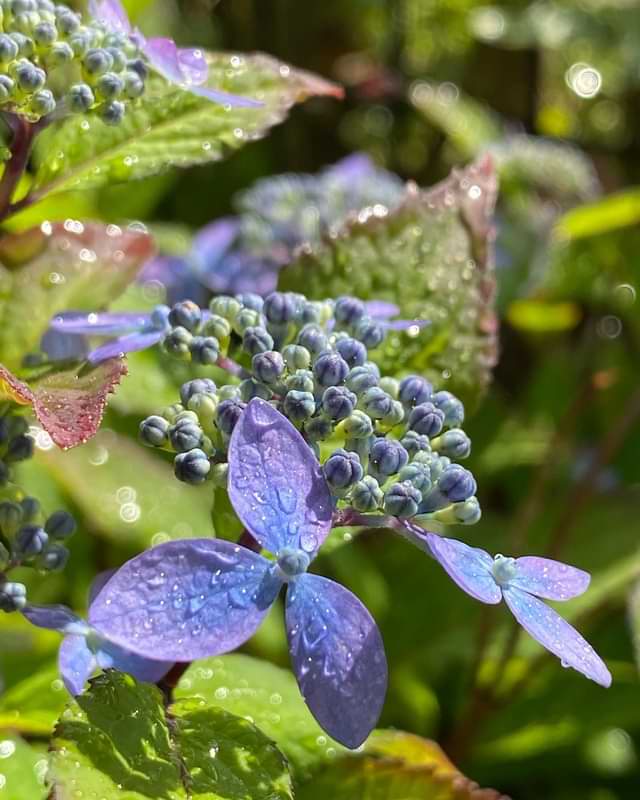
The Senhime variety (千姫 o センヒメ) is native to the prefecture of Hiroshima and is characterized by pale blue corymbs and petals that vary depending on the acidity of the soil.
Seto-no-tsuki
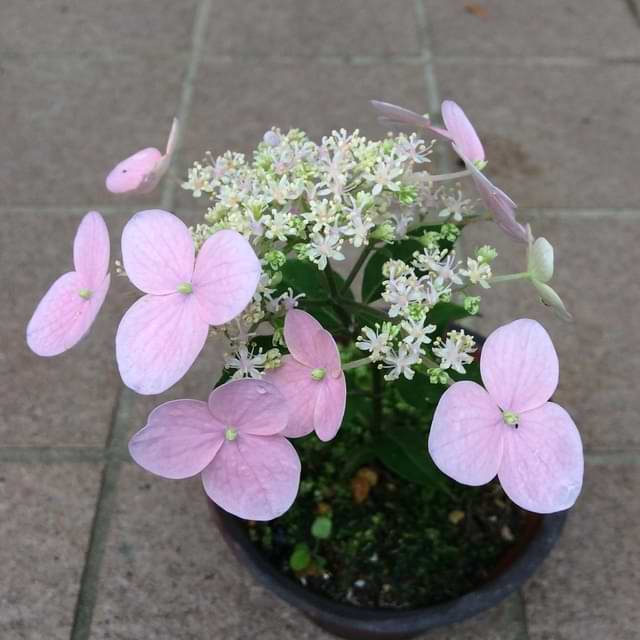
The Seto-no-tsuki variety (瀬戸の月 o セトノツキ) is native to Kōchi prefecture, south of the island of Shikoku. Its petals are slightly overlapping and their color is very pale which varies according to the acidity of the soil, from pink to blue.
Shichidanka
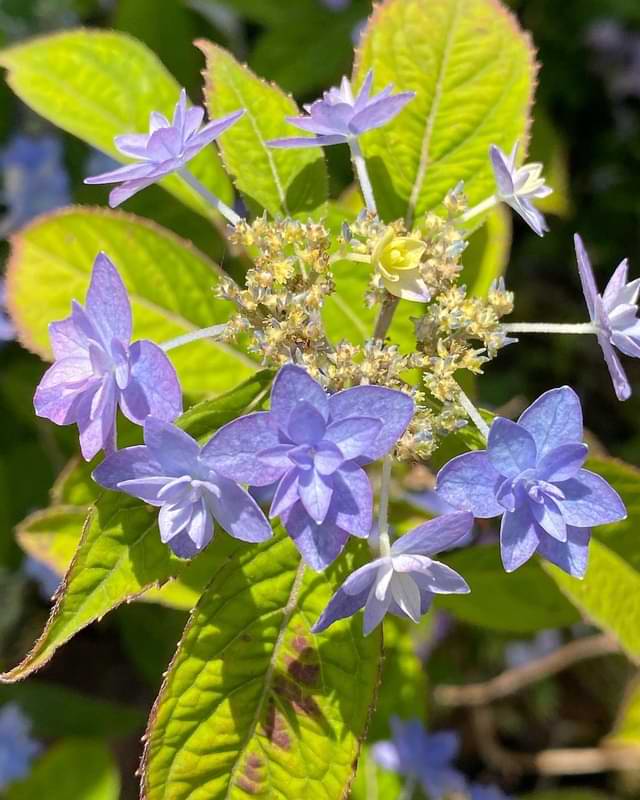
The Shichidanka variety (七段花 o シチダンカ) is native to Mount Rokkō, in Hyōgo prefecture. What characterizes this hydrangea are the overlapping Yae-shaped flowers, in which each petal is pointed like a sword.
Shiromaiko
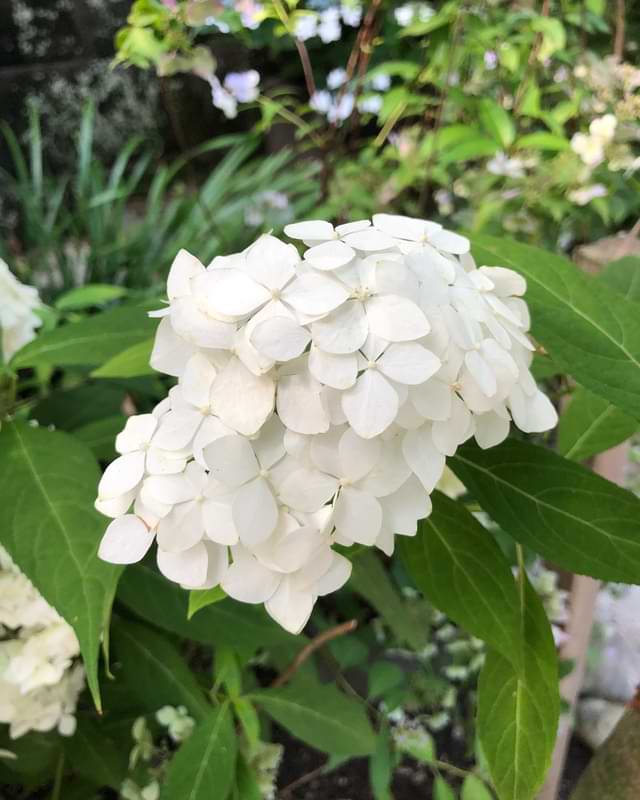
The Shiromaiko variety (白舞妓 o シロマイコ) is native to the slopes of Mount Fuji, in Shizuoka prefecture. Like the Maiko variety, it has a spherical “Temari” flowering of a very pure white without blue hues, and tends to bloom again in late summer.
Shirotae
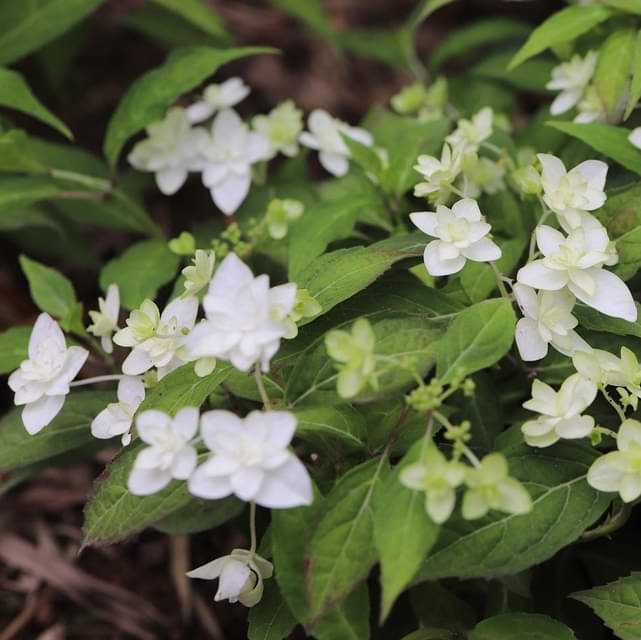
The last variety is the Shirotae (白妙 or シロタエ), native to the mountain valleys of the Abe River, between the prefecture of Yamanashi and Shizuoka.
It is also called Yae Amagi Amacha due to the similarity to the Amagi Amacha described above but with petals from the superimposed double star Yae, but its leaves cannot be used for sweet hydrangea tea.
Other Japanese hydrangeas
In addition to the hydrangeas of the macrophylla species, there are two other species of hydrangea native to Japan and widely cultivated in the country, the paniculata and the petiolaris.
Hydrangea paniculata (noriuajisai)
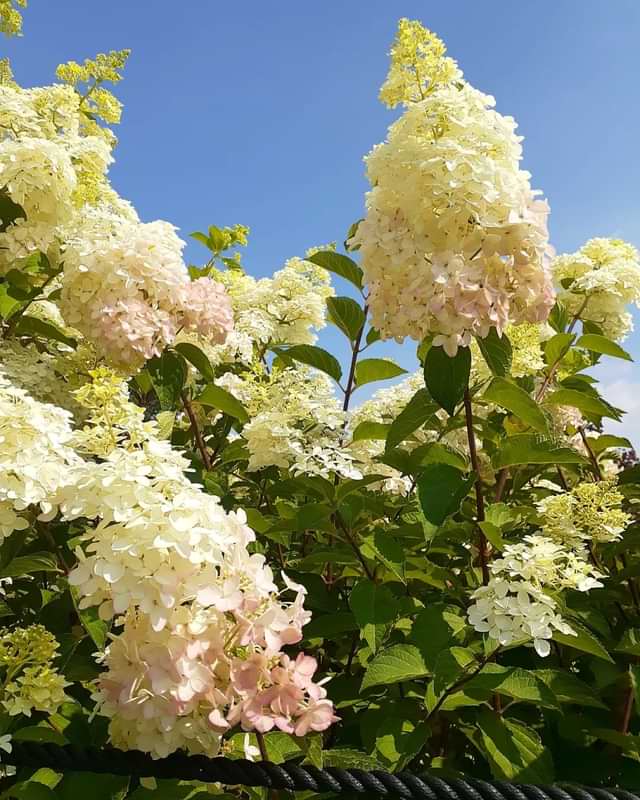
Hydrangea paniculata, in Japanese noriutsugi (糊空木 or ノリウツギ) is a robust plant that can reach 3 meters in height, which makes it cultivable both as a bush and as a tree.
It is characterized by oval leaves with toothed edges and a dark green color. The inflorescences have an elongated shape and are composed of numerous four-petaled flowers whose color goes from white to pink, a color that intensifies in particular towards the last periods of flowering.
This species tolerates low temperatures quite well and, like the other ajisai, prefers dimly lit areas that are not directly exposed to sunlight during the hottest hours. In fact, the ideal is to grow it in gardens where other plants create the right shaded areas to shelter the paniculate from the sun.
Hydrangea petiolaris (tsuruajisai)
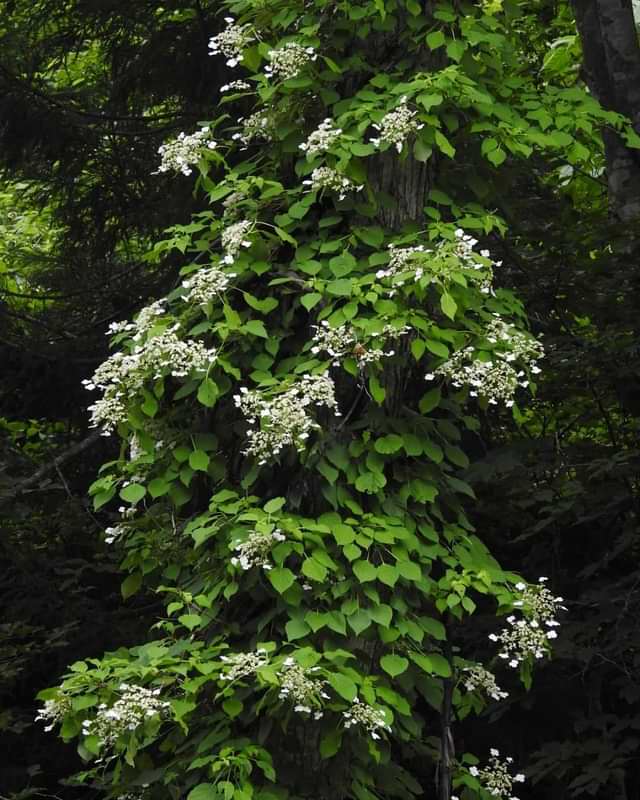
One of the most spectacular examples of hydrangeas originating in Japan is the Hydrangea petiolaris, tsuruajisai in Japanese (蔓 紫陽 花 or ツルアジサイ) or climbing hydrangea, a name that describes it very well: this species, equipped with aerial roots from the branches, climbs up to to reach 20 meters in height if it is grown at the base of tall trees or rocky cliffs.
The tsuruajisai is able to withstand temperatures that even drop below zero, thus demonstrating a strong ability to adapt to cultivation in areas characterized by cold winters. It does not require pruning unless you want to contain its size: in this case, pruning generally takes place in the month of February.
The climbing hydrangea is characterized by shiny oval-shaped leaves and toothed edges, bright green during the growing season and golden yellow in autumn, giving life to wonderful foliage. Flowering begins in late spring with irregularly shaped cream-white flowers gathered in flat corymbs, enlivening Japanese landscapes for most of the summer.
Other hydrangeas from the world
Finally, we mention two species of hydrangea not native to Japan but still very widespread all over the world.
Hydrangea quercifolia
Hydrangea quercifolia (カシワバアジサイ), or “oak-leaf hydrangea”, is a shrub native to the United States that takes its name from the shape of its leaves, which resemble those of an oak. If planted in sunny soils with a few hours in the afternoon in the shade, in autumn the leaves of the Oakleaf take on shades from bright red, to orange, to yellow and even to burgundy (reminiscent of the shades of momiji, the red maple leaves! ).
Oakleaf prefers drier and less humid soils than other cultivars, with an acidity of pH between 5.0 and 6.5 and a generous addition of compost. The more sun it gets, the more frequently it needs to be watered. In addition, it blooms best in areas where summers are pleasantly warm and can withstand the cold winter temperatures more than hydrangea macrophylla.
Some variants of Oakleaf are the “Snowflake”, characterized by double flowers, the “Snow Queen”, with white flowers in early summer that turn pink-brown in autumn, and finally the “Ruby Slippers”, with red flowers.
Hydrangea arborescens
Hydrangea arboscenses, or “shrubby hydrangea”, is a plant native to the eastern United States and distributed from New York to Florida and from western Oklahoma to south-eastern Kansas. It is also the first hydrangea introduced in Europe in 1736, more precisely in England.
This hydrangea is a small to medium-sized deciduous shrub that reaches up to 3 meters in height. Despite tolerating clayey soils and also tolerating drought well, this cultivar prefers humid soils and gives its best in very acid soils, with a pH of about 4.5. It is common to see it along the banks of streams and on the edges of wooded roads, as it prefers areas located in semi-darkness.
The leaves are opposite and deciduous, have an oval shape and a serrated edge, and measure approximately 8-18 cm in length. The inflorescence is instead formed by a corymb which initially has a flat shape and then becomes more globular. The flowers are white and mostly sterile. The flowering period starts from mid-June and reaches the first colds.

